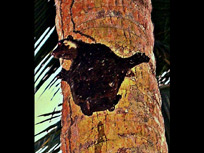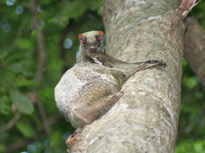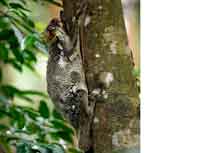Dermoptera -- Flying Lemurs : Close Relatives of Primates?



Origins
Colugos (also misleadingly labeled flying lemurs, although they are not lemurs and do not fly) exhibit a mosaic of features, some of which show individual similarities to bats, shrews, or monkeys, while others are unique. Their most striking characteristics are adaptations for gliding. Because of their many unique features, the two colugo species have long been classified in an independent order of placental mammals (Dermoptera, literally meaning "skin-wings").
Although colugos are now generally regarded as an unusual and isolated mammalian lineage, they have been variously linked to insectivores (Insectivora), bats (Chiroptera), and/or primates (Primates). Some affinity to bats has often been suspected because of the potential link between gliding and actual flight.
What are they like?
It bears repeating that they do not fly. They glide around beautifully on exquisite gliding membranes: a furred skin extending from behind the ears outward to the digits, embracing the tail, stretching along the sides and base of the body. This membrane enables flying lemurs to glide up to 150 yards (one and one-half football fields long). They are among the largest of all gliding mammals. They are about the size of a domestic cat, and their large eyes and pointed face lend them a certain resemblance to lemurs.
So highly specialized are colugos to their life in the treetops (they have long, curved, sharp claws on hands and feet) that they are clumsy crawlers on the ground. At dusk they emerge from their daytime retreat in a tree hollow to glide from tree to tree until they reach favored foraging areas, where they get to the serious business of feeding.
Geographic Distribution
View Larger Map
Only two living species, in a single genus, compose the entire order of flying lemurs. One species is found in the Philippines; the other from southeast Asia to Java and Borneo.
Reproduction
Little is known about colugo mating habits but we do know that the pregnancy is usually about 60 days and newborn flying lemurs are relatively undeveloped until weaned. They are carried clinging to the belly of the mother, who can also fold the gliding membrane near the tail into a soft, warm pouch for this purpose. Very much like marsupials !
Feeding Habits
Colugos subsist on a steady diet of buds, leaves and flowers. They sometimes snack on fruit too. They get water from licking leaves and also from their food.
Species within Family Cynocephalidae
Cynocephalus volans (Philippine Flying Lemur)
Galeopterus variegatus (Sunda Flying Lemur)
Videos